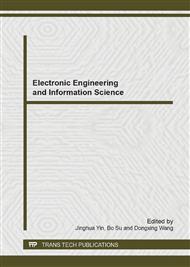[1]
Ching-Hsue Cheng, A new approach for ranking fuzzy numbers by distance method[J], Fuzzy Sets and Systems, 1998, 95(3): 307-317.
DOI: 10.1016/s0165-0114(96)00272-2
Google Scholar
[2]
B. Asady, A. Zendehnam, Ranking fuzzy numbers by distance minimization[J], Applied Mathematical Modelling, 2007, 31(11): 2589-2598.
DOI: 10.1016/j.apm.2006.10.018
Google Scholar
[3]
Debashree Guha, Debjani Chakraborty, A new approach to fuzzy distance measure and similarity measure between two generalized fuzzy numbers[J], Applied Soft Computing, 2010, 10 (1): 90-99.
DOI: 10.1016/j.asoc.2009.06.009
Google Scholar
[4]
Diamond P, Kloeden P. Metric space of fuzzy set: Theory and application[M]. Singapore: World Scientific, (1994).
Google Scholar
[5]
Wu C X, Ma M, Fang J X. Structure theory of fuzzy analytics[M]. Gui-yang: Gui-zhou Science and Technology Press, 1994. (In Chinese).
Google Scholar
[6]
Guo S Z. Principle of fuzzy mathematical analysis based on structured element[M]. Shen-yang: Northeastern University Press, 2004. (In Chinese).
Google Scholar
[7]
Amelia Bilbao Terol, A new approach for multiobjective decision making based on fuzzy distance minimization, Mathematical and Computer Modelling, 2008, 47(9-10): 808-826.
DOI: 10.1016/j.mcm.2007.05.006
Google Scholar
[8]
Miin-Shen Yang, Cheng-Hsiu Ko, On a class of fuzzy c-numbers clustering procedures for fuzzy data[J], Fuzzy Sets and Systems, 1996, 84(1): 49-60.
DOI: 10.1016/0165-0114(95)00308-8
Google Scholar
[9]
Phil Diamond, Peter Kloeden, Characterization of compact subsets of fuzzy sets[J], Fuzzy Sets and Systems, 1989, 29(3): 341-348.
DOI: 10.1016/0165-0114(89)90045-6
Google Scholar
[10]
Phil Diamond, Peter Kloeden, Metric spaces of fuzzy sets[J], Fuzzy Sets and Systems, 1990, 35(2): 241-249.
DOI: 10.1016/0165-0114(90)90197-e
Google Scholar
[11]
Diamond P, Kloeden P. Metric spaces of fuzzy sets: Theory and application[M]. Singapore, London: World Scientific Publishing, (1994).
Google Scholar
[12]
William Voxman, Some remarks on distances between fuzzy numbers, Fuzzy Sets and Systems , 1998, 100( 1–3): 353-365.
DOI: 10.1016/s0165-0114(97)00090-0
Google Scholar
[13]
L Tran, L Duckstein. Comparison of fuzzy numbers using a fuzzy distance measure[J]. Fuzzy Sets and Systems, 2002, 130: 331~341.
DOI: 10.1016/s0165-0114(01)00195-6
Google Scholar
[14]
Liu M, Li F C, Wu D. Measure of the difference between fuzzy numbers based on its plane distance application in optimal scheduling problem[J]. China Science and E Keywords, 2003, 33(12): 1138-1148. (In Chinese).
Google Scholar
[15]
Guo S Z. Homeomorphic property between fuzzy number space and monotone function with same formal on [ -1, 1][J]. Advances in Natural Science, 2004, 14(11): 1318-1321. (In Chinese).
Google Scholar


